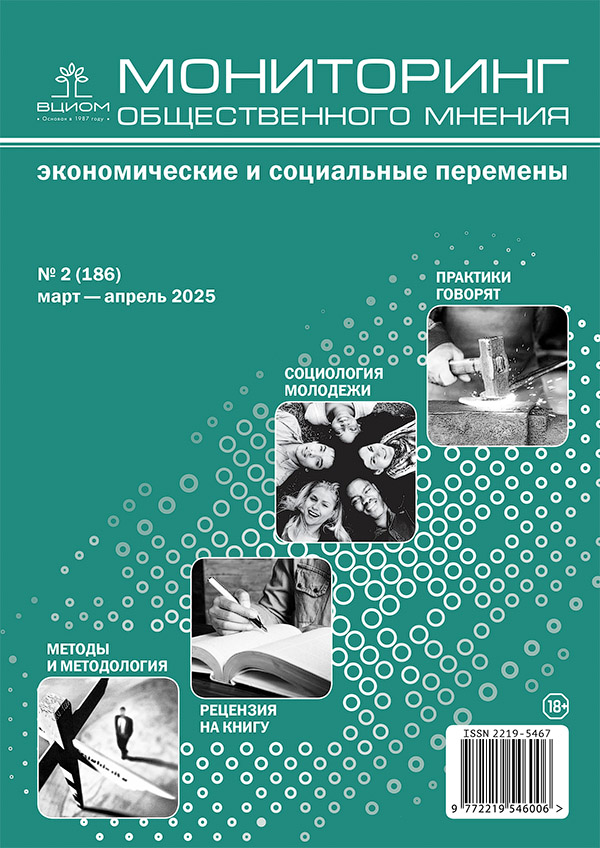Texts of Court Verdicts as a Data Source for Empirical Legal Studies in Russia
DOI:
https://doi.org/10.14515/monitoring.2025.2.2575Keywords:
web scraping, open data, law enforcement, court statistics, court verdicts, empirical legal studies, text miningAbstract
The development of empirical legal studies in Russia is restricted by the lack of sources of disaggregated data on law enforcement available to social researchers. One of the potential sources of such data, which is still insufficiently used in Russian research, is the publicly available texts of court verdicts, in particular court sentences. This article proposes a methodology for using the texts of court verdicts as a possible data source that may be of interest to sociologists conducting empirical research on law and law enforcement in Russia.
Based on their own experience of sentencing research, the authors describe possible options for the collection, preprocessing, and analysis of such texts using text-mining techniques. As an illustration, a recent study of gender differences in sentences for murder under Article 105 Part 1 of the Criminal Code of the Russian Federation is used. The discussion of the potential of using sentencing texts is complemented by an overview of alternative sources of judicial data available in Russia, as well as a reflection on the advantages and limitations of sentencing texts compared to other sources of legal information.
Acknowledgments. The research was supported by a grant from the Russian Science Foundation No. 23-78-10073 “Development and approbation of the algorithm for automated analysis of the court decisions texts for socio-legal studies (based on cases of violent crimes)” (see more details: https://rscf. ru/project/23-78-10073/).
References
Веркеев А. М., Волков В. В., Дмитриева А. В., Кнорре А. В., Кудрявцев В. Е., Кузнецова Д. А., Кучаков Р. К., Титаев К. Д., Ходжаева Е. А. Как изучать жертв преступлений? // Мониторинг общественного мнения: Экономические и социальные перемены. 2019. № 2. С. 4—31. https://doi.org/10.14515/monitoring.2019.2.01.
Verkeev A. M., Volkov V. V., Dzmitryieva A. V., Knorre A. V., Kudryavtsev V. E., Kuznetsova D. A., Kuchakov R. K., Titaev K. D., Khodzhaeva E. A. (2019) How to Study Victims of a Crime? Monitoring of Public Opinion: Economic and Social Changes. No. 2. P. 4-31. (In Russ.) https://doi.org/10.14515/monitoring.2019.2.01.
Волков В. В. Влияние социального статуса подсудимого на решение суда // Журнал социологии и социальной антропологии. 2014. Т. 17. № 4. С. 62—85.
Volkov V. V. (2014) The Influence of Socio-Economic Status of Defendants on Court Decisions. Journal of Sociology and Social Anthropology. Vol. 17. No. 4. P. 62—85. (In Russ.)
Волков В. В. Эмпирическая социология права в условиях междисциплинарного синтеза // Социологические исследования. 2017. № 4. С. 34—42.
Volkov V. V. (2017) The Empirical Sociology of Law in the Context of Interdisciplinary Synthesis. Sociological Studies. No. 4. P. 34—42. (In Russ.)
Волков В. В., Скугаревский Д. А., Титаев К. Д. Проблемы и перспективы исследований на основе Big Data (на примере социологии права) // Социологические исследования. 2016. № 1. С. 48—58.
Volkov V. V., Skougarevskiy D. A., Titaev K. D. (2016) Problems and Prospects for Studies Based on Big Data (the Case of Sociology of Law). Sociological Studies. No. 1. P. 48—58. (In Russ.)
Казyн А.П. Может ли искусственный интеллект прогнозировать решения суда? Систематический обзор международных исследований // Мониторинг общественного мнения: Экономические и социальные перемены. 2024. № 5. С. 100—122. https://doi.org/10.14515/monitoring.2024.5.2580.
Kazun A. P. (2024) Can Artificial Intelligence Predict Court Decisions? A Systematic Review of International Research. Monitoring of Public Opinion: Economic and Social Changes. No. 5. P. 100—122. https://doi.org/10.14515/monitoring.2024.5.2580. (In Russ.)
Кнорре А. В., Титаев К. Д. Преступность и виктимизация в России. Результаты всероссийского виктимизационного опроса (Аналитический обзор). СПб.: ИПП ЕУ СПб, 2018.
Knorre A., Titaev K. (2018) Crime and Victimization in Russia. The Results of the All-Russian Victimization Survey (Analytical Review). St. Petersburg: EUSP Press. (In Russ.)
Поздняков М. Л. Доступ к судебным актам судов общей юрисдикции: мониторинг применения Федерального закона от 22 декабря 2008 г. N 262-ФЗ «Об обеспечении доступа к информации о деятельности судов в Российской Федерации». СПб.: ИПП ЕУ СПб, 2011a.
Pozdnyakov M. (2011a) Access to Judicial Acts of Courts of General Jurisdiction: Monitoring the Application of Federal Law No. 262-FZ Dated December 22, 2008 “On Ensuring Access to Information on the Activities of Courts in the Russian Federation”. St. Petersburg: EUSP Press. (In Russ.)
Поздняков М. Л. Мониторинг открытости правосудия. СПб.: ИПП ЕУ СПб, 2011b.
Pozdnyakov M. (2011b) Monitoring the Openness of Justice. St. Petersburg: EUSP Press. (In Russ.)
Поздняков М. Л. Организационные и структурные ограничения при доступе к судебным актам судов общей юрисдикции. СПб.: ИПП ЕУ СПб, 2012.
Pozdnyakov M. (2012) Organizational and Structural Restrictions on Access to Judicial Acts of Courts of General Jurisdiction. St. Petersburg: EUSP Press. (In Russ.)
Серебренников Д., Титаев К. Д. Динамика преступности и виктимизации в России 2018—2021 гг. Результаты второго виктимизационного опроса: аналитический обзор. СПб.: ИПП ЕУ СПб, 2022.
Serebrennikov D., Titaev K. (2022) The Dynamics of Crime and Victimization in Russia 2018-2021. The Results of the Second Victimization Survey: An Analytical Review. St. Petersburg: EUSP Press. (In Russ.)
Титаев К. Д. Предварительное заключение в российской уголовной юстиции: социологический анализ вероятности предварительного заключения и его влияния на решение суда // Экономическая социология. 2014. Т. 15. № 3. С. 88—113.
Titaev K. D. (2014) Pretrial Detention in Russian Criminal Justice: Sociological Analysis of the Probability of Pretrial Detention and its Influence on Court Decisions. Economic Sociology. Vol. 15. No. 3. P. 88—113. (In Russ.)
Титаев К. Д., Скугаревский Д. А., Кнорре А. В., Кудрявцев В. Е., Шклярук М. С. Манифест новой количественной криминологии “Уголовная политика с опорой на данные” // Вестник Санкт-Петербургского университета. Право. 2018. Т. 9. № 1. С. 91—101. https://doi.org/10.21638/11701/spbu14.2018.107.
Titaev K. D., Skougarevskiy D. A., Knorre A. V., Kudryavtsev V. E., Shklyaruk M. S. (2018) A New Quantitative Criminology Manifesto: Evidence Based Criminal Justice Policymaking. Vestnik of Saint Petersburg University. Law. Vol. 9. No. 1. P. 91—101. (In Russ.) https://doi.org/10.21638/11701/spbu14.2018.107.
Фридман Л. М. Взросление: исследования права и общества вступают в эксклюзивный клуб // Право и правоприменение в зеркале социальных наук: хрестоматия современных текстов / под ред. Э. Л. Панеях. М.: Статут, 2014. С. 184—200.
Friedman L. M. (2014) Coming of Age: Law and Society Enters an Exclusive Club. In: Paneyakh E. (ed.) Law And Application of Law in the Mirror of Social Sciences: Digest of Modern Texts. Moscow: Statut. P. 184—200. (In Russ.)
Четверикова И. В. Роль семьи, профессиональной карьеры и пола подсудимых при вынесении приговоров российскими судьями // Журнал социологии и социальной антропологии. 2014. Т. 17. № 4. С. 101—123.
Chetverikova I. V. (2014) The Impact of Family, Professional Status and Gender of Defendants on Sentencing Decisions by Russian Judges. Journal of Sociology and Social Anthropology. Vol. 17. No. 4. P. 101—123. (In Russ.)
Четверикова И. В., Титаев К. Д. Социологический анализ оптимального правоприменения: типичные случаи избыточной криминализации экономической деятельности в России // Вопросы экономики. 2019. № 3. С. 142—158. https://doi.org/10.32609/0042-8736-2019-3-142-158.
Chetverikova I. V., Titaev K. D. (2019) Sociological Perspective on the Optimal Law Enforcement: Typical Cases of Overcriminalization of Economic Activity in Russia. Voprosy Ekonomiki. No. 3. P. 142—158. (In Russ.) https://doi.org/10.32609/0042-8736-2019-3-142-158.
Шклярук М. С. Правовая статистика: системный конфликт между знанием о преступности и учетом ведомственной работы. СПб.: ИПП ЕУ СПб, 2014.
Shklyaruk M. S. (2014) Legal Statistics: A Systemic Conflict between Knowledge about Crime and Accounting for Departmental Work. St. Petersburg: EUSP Press. (In Russ.)
Шклярук М., Скугаревский Д., Дмитриева А., Скифский И., Бегтин И. Криминальная статистика: механизмы формирования, причины искажения, пути реформирования: исследовательский отчет. СПб.; Москва: Норма, Центр независимых социальных исследований и образования, 2015.
Shklyaruk M., Skougarevskiy D., Dzmitryieva A., Skifsky I., Begtin I. (2015) Criminal Statistics: Mechanisms of Formation, Causes of Distortion, Ways of Reform: Research Report. St. Petersburg; Moscow: Norma, Center for Independent Social Research and Education.
Юрченко Р. Н., Сакалов Б. З. О применении новых технологий в системе правосудия // Вестник Института законодательства и правовой информации Республики Казахстан. 2009. Т. 2. № 14. С. 89—95.
Yurchenko R., Sakalov B. (2009) On the Application of New Technologies in the Justice System. Bulletin of the Institute of Legislation and Legal Information of the Republic of Kazakhstan. Vol. 2. No. 14. P. 89—95.
Addington L. A. (2008) Assessing the Extent of Nonresponse Bias on NIBRS Estimates of Violent Crime. Journal of Contemporary Criminal Justice. Vol. 24. No. 1. P. 32—49. https://doi.org/10.1177/1043986207312936.
Ahl B., Sprick D. (2018) Towards Judicial Transparency in China: The New Public Access Aatabase for Court Decisions. China Information. Vol. 32. No. 1. P. 3—22, doi: https://doi.org/10.1177/0920203X17744544.
Alcántara Francia O. A., Nunez-del-Prado M., Alatrista-Salas H. (2022) Survey of Text Mining Techniques Applied to Judicial Decisions Prediction. Applied Sciences. Vol. 12. No. 20. P 10200. https://doi.org/10.3390/app122010200.
Aletras N., Tsarapatsanis D., Preoţiuc-Pietro D., Lampos V. (2016) Predicting Judicial Decisions of the European Court of Human Rights: A Natural Language Processing Perspective. PeerJ Computer Science. Vol. 2. P. e93. https://doi.org/10.7717/peerj-cs.93.
Ansari S., He N. (2015) Convergence Revisited: A Multi-Definition, Multi-Method Analysis of the UCR and the NCVS Crime Series (1973-2008). Justice Quarterly. Vol. 32. No. 1. P. 1—31. https://doi.org/10.1080/07418825.2012.718355.
Ashley K. D., Brüninghaus S. (2009) Automatically Classifying Case Texts and Predicting Outcomes. Artificial Intelligence and Law. Vol. 17. No. 2. P. 125—165. https://doi.org/10.1007/s10506-009-9077-9.
Cao Y., Ash E., Chen D.L. (2020) Automated Fact-Value Distinction in Court Opinions. European Journal of Law and Economics. Vol. 50. No. 3. P. 451—467. https://doi.org/10.1007/s10657-020-09645-7.
Gasparetto A., Marcuzzo M., Zangari A., Albarelli A. (2022) A Survey on Text Classification Algorithms: From Text to Predictions. Information, Vol. 13, No. 2,: 83. https://doi.org/10.3390/info13020083
Grimmer J., Stewart B. M. (2013) Text as Data: The Promise and Pitfalls of Automatic Content Analysis Methods for Political Texts. Political Analysis. Vol. 21. No. 3. P. 267—297. https://doi.org/10.1093/pan/mps028.
Hartel P., van Wegberg R., van Staalduinen M. (2023) Investigating Sentence Severity with Judicial Open Data: A Case Study on Sentencing High-Tech Crime in the Dutch Criminal Justice System. European Journal on Criminal Policy and Research. Vol. 29. No. 4. P. 579—599. https://doi.org/10.1007/s10610-021-09503-5.
Hipp J. R., Bates C., Lichman M., Smyth P. (2019) Using Social Media to Measure Temporal Ambient Population: Does it Help Explain Local Crime Rates? Justice Quarterly. Vol. 36. No. 4. P. 718—748. https://doi.org/10.1080/07418825.2018.1445276.
Kaur H., Choudhury T., Singh T. P., Shamoon M. (2019) Crime Analysis using Text Mining. In: 2019 International Conference on Contemporary Computing and Informatics (IC3I). Singapore: IEEE. P. 283—288. https://doi.org/10.1109/IC3I46837.2019.9055606.
Kovalchuk O., Banakh S., Masonkova M., Berezka K., Mokhun S., Fedchyshyn O. (2022) Text Mining for the Analysis of Legal Texts. In: 2022 12th International Conference on Advanced Computer Information Technologies (ACIT). Ruzomberok: IEEE. P. 502—505. https://doi.org/10.1109/ACIT54803.2022.9913169.
Loftin C., McDowall D. (2010) The Use of Official Records to Measure Crime and Delinquency. Journal of Quantitative Criminology. Vol. 26. No. 4. P. 527—532. https://doi.org/10.1007/s10940-010-9120-8.
Lundman R. J. (2003) The Newsworthiness and Selection Bias in News About Murder: Comparative and Relative Effects of Novelty and Race and Gender Typifications on Newspaper Coverage of Homicide. Sociological Forum. Vol. 18. No. 3. P. 357—386. https://doi.org/10.1023/A:1025713518156.
Metsker O., Trofimov E., Petrov M., Butakov N. (2019) Russian Court Decisions Data Analysis Using Distributed Computing and Machine Learning to Improve Lawmaking and Law Enforcement. Procedia Computer Science. Vol. 156. P. 264—273. https://doi.org/10.1016/j.procs.2019.08.202.
Moens M.-F. (2007) Summarizing Court Decisions. Information Processing & Management. Vol. 43. No. 6. P. 1748—1764. https://doi.org/10.1016/j.ipm.2007.01.005.
Nolan III J. J., McDevitt J., Cronin S., Farrell A. (2004) Learning to See Hate Crimes: A Framework for Understanding and Clarifying Ambiguities in Bias Crime Classification. Criminal Justice Studies. Vol. 17. No. 1. P. 91—105. https://doi.org/10.1080/08884310420001679361.
Ozkan T. (2019) Criminology in the Age of Data Explosion: New Directions. The Social Science Journal. Vol. 56. No. 2. P. 208—219. https://doi.org/10.1016/j.soscij.2018.10.010.
Paneyakh E. (2014) Faking Performance Together: Systems of Performance Evaluation in Russian Enforcement Agencies and Production of Bias and Privilege. Post-Soviet Affairs. Vol. 30. No. 2—3. P. 115—136. https://doi.org/10.1080/1060586X.2013.858525.
Pickett J. T., Mancini C., Mears D. P., Gertz M. (2015) Public (Mis)Understanding of Crime Policy: The Effects of Criminal Justice Experience and Media Reliance. Criminal Justice Policy Review. Vol. 26. No. 5. P. 500—522. https://doi.org/10.1177/0887403414526228.
Pina-Sánchez J., Grech D., Brunton-Smith I., Sferopoulos D. (2019) Exploring the Origin of Sentencing Disparities in the Crown Court: Using Text Mining Techniques to Differentiate between Court and Judge Disparities. Social Science Research. Vol. 84. Art. 102343. https://doi.org/10.1016/j.ssresearch.2019.102343.
Pina-Sánchez J., Roberts J. V., Sferopoulos D. (2019) Does the Crown Court Discriminate Against Muslim-named Offenders? A Novel Investigation Based on Text Mining Techniques. The British Journal of Criminology. Vol. 59. No. 3. P. 718—736. https://doi.org/10.1093/bjc/azy062.
Poulin D., Mowbray A. (2007) Free Access to Law and Open Source Software. In: St. Amant K., Still B. (eds.). Handbook of Research on Open Source Software. Hershey, PA: IGI Global. P. 373—381. https://doi.org/10.4018/978-1-59140-999-1.ch029.
Prasad N., Boughanem M., Dkaki T. (2024) Exploring Large Language Models and Hierarchical Frameworks for Classification of Large Unstructured Legal Documents. Springer. https://doi.org/10.1007/978-3-031-56060-6_15.
Rand M. (2006) The National Crime Victimization Survey: 34 Years of Measuring Crime in the United States. Statistical Journal of the United Nations Economic Commission for Europe. Vol. 23. No. 4. P. 289—301. https://doi.org/10.3233/SJU-2006-23406.
Schwartz J., Vega A. (2017) Sources of Crime Data. In: Teasdale B., Bradley M.S. (eds.) Preventing Crime and Violence. Cham: Springer International Publishing. P. 155—167. https://doi.org/10.1007/978-3-319-44124-5_14.
Shu D., Sen S. (2023) Analyzing Hong Kong’s Legal Judgments from a Computational Linguistics point-of-view. arXiv. https://doi.org/10.48550/arXiv.2305.02558 (accessed: 28.04.2025).
Turkanova V. (2023) Prospects for the Use of Artificial Intelligence and Machine Learning Algorithms for Effective Resolution of Civil Disputes. Access to Justice in Eastern Europe. Vol. 6. No. 2. P. 232—241. https://doi.org/10.33327/AJEE-18-6.2-n000224.
Volkov V. (2016) Legal and Extralegal Origins of Sentencing Disparities: Evidence from Russia’s Criminal Courts. Journal of Empirical Legal Studies. Vol. 13. No. 4. P. 637—665. https://doi.org/10.1111/jels.12128.
Volkov V., Skougarevskiy D., Kuchakov R. (2023) Whither Repeat Players? Litigation Experience and Success in Court: Evidence from Russian Commercial Courts. Social Science Research. Vol. 112. P. 102875. https://doi.org/10.1016/j.ssresearch.2023.102875.
Wu X., Roberts M. E., Stern R. E., Liebman B. L., Gupta A., Sanford L. (2022) Augmenting Serialized Bureaucratic Data: The Case of Chinese Courts. 21st Century China Center Research Paper No. 2022-11. URL: https://doi.org/10.2139/ssrn.4124433.
Zhuchkova S., Kazun A. (2023) Exploring Gender Bias in Homicide Sentencing: An Empirical Study of Russian Court Decisions Using Text Mining. Homicide Studies. https://doi.org/10.1177/10887679231217159.
Downloads
Published
How to Cite
Issue
Section
License
Copyright (c) 2025 Monitoring of Public Opinion: Economic and Social Changes

This work is licensed under a Creative Commons Attribution-NonCommercial-ShareAlike 4.0 International License.






